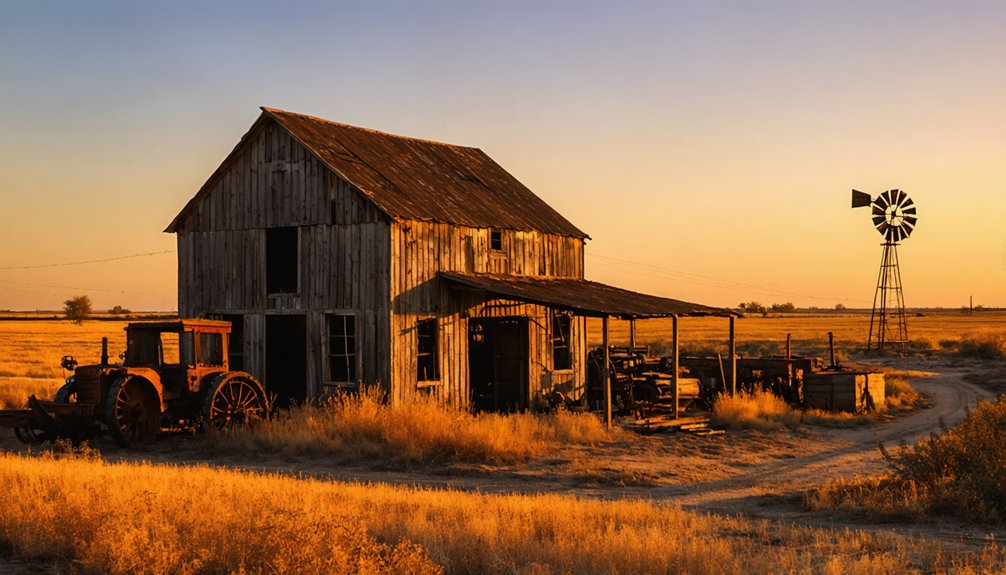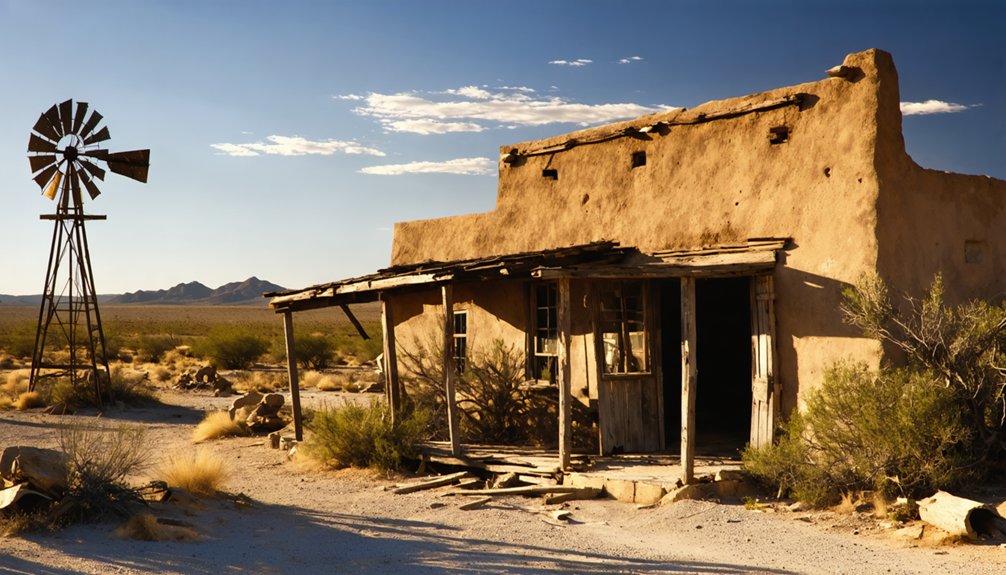You’ll find Casa Piedra, a limestone ghost town 25 miles southeast of Marfa, Texas, built by Domenicio Mata in the late 1890s. The stone house anchored a thriving farming community that grew to fifty families by 1900, complete with a post office, store, and schoolhouse. After reaching its peak in the 1920s, the Great Depression and severe drought forced residents to abandon the settlement. The weathered ruins still stand as silent witnesses to this once-vibrant border community’s story.
Key Takeaways
- Casa Piedra was founded in 1883 by Domenicio Mata, featuring a distinctive limestone house that gave the settlement its name.
- The community thrived from 1900-1920 with fifty farming families, a school, post office, and vibrant cultural celebrations.
- Economic decline began in the 1930s due to the Great Depression and severe drought conditions.
- By 1933, the population dropped to just ten residents, leading to closure of essential services.
- The post office closed in 1953 and the mercantile store in 1957, marking the final decline into ghost town status.
The Stone House That Started It All
When Domenicio Mata built his stone house in the late 1890s on preemption land in Casa Piedra, Texas, he couldn’t have known that his homestead would become the cornerstone of a thriving farming community.
The stone architecture, crafted from local limestone, featured thick walls that kept settlers cool in summer and warm in winter. The Vsquez and Russell clans were among the most prominent families who settled near the iconic structure.
Limestone walls, masterfully constructed from local stone, created a natural climate control system for frontier families year-round.
You’ll find the hallmarks of late 19th-century Texas construction in its coursed rubble pattern, central chimney, and wide tongue-and-groove pine flooring. This durable design proved essential for frontier life.
At twenty feet tall, this impressive structure mirrored the architectural ambition seen in other significant Texas buildings of the era.
The house’s historical significance extends beyond its physical presence – it gave Casa Piedra its name, meaning “The Stone House,” and anchored a community that grew to over fifty families by 1900.
Around it, settlers cultivated cotton, corn, beans, and hay, establishing a prosperous agricultural hub.
Early Settlement and Community Growth
You’ll find Casa Piedra‘s earliest roots began with Dionicio Mata’s 1884 homestead at Punta del Agua, where he later built the stone house that gave the settlement its name.
Like the historic Old Stone Fort of Nacogdoches, the building served as a vital trading post and gathering place for the growing community.
By 1900, more than 50 families had established themselves in the area, cultivating cotton, corn, beans, and hay through irrigated farming methods.
The community’s growth accelerated after Conrado Vasquez opened a store and post office in 1912, providing essential services to the expanding population of farmers and ranchers. The settlement became an established unincorporated community in 1883, situated near vital waterways and agricultural lands.
Pioneer Families Establish Roots
In the late 1800s, Casa Piedra‘s pioneer families laid the foundation for a thriving agricultural community along Alamito Creek.
You’ll find the pioneering spirit exemplified by Dionicio Mata, who homesteaded 160 acres at Punta del Agua in 1884 before establishing the iconic rock house “Casa Piedra” in the 1890s.
Around the same time, John Davis and several Mexican-descent families created lasting family legacies by developing irrigated farms along Alamito Creek. Their settlement patterns reflected Texas’s rich administrative history, as the region had previously been governed from San Felipe de Austin, the capital of the first Anglo-American colony. The nearby Casa Piedra Road became known for its breathtaking vistas and vibrant displays of ocotillo cactus blooms.
Stone House Creates Community
Standing as a symbol of frontier resilience, Dionicio Mata’s stone house became the heart of Casa Piedra’s emerging community in the 1880s.
Built on a 160-acre homestead at Punta del Agua, the structure’s architectural significance went beyond its role as a residence. You’ll find it served as both a protective fortress against threats and a commercial hub for early settlers.
The stone house’s presence sparked remarkable community growth. By 1900, you could see over 50 families farming the surrounding lands, cultivating cotton, corn, beans, and hay.
The area’s development accelerated when Conrado Vasquez opened a store and post office in 1912, transforming Casa Piedra into a crucial service center.
The settlement’s position along the Chihuahua Trail enhanced its importance as a trade stopover.
Life in the Border Region
If you’d visited Casa Piedra in the early 1900s, you would’ve found a vibrant community where Hispanic and American frontier cultures merged through cross-border trade and social interactions.
The close-knit Russell and Vasquez families maintained strong connections with Mexican merchants while adapting to American farming practices and educational systems. The town grew to accommodate fifty farming families by 1900, creating a bustling agricultural community. Like other settlements in the region, they revolutionized their farming through the introduction of irrigation systems in 1914.
Your observations would’ve revealed how the town’s position near the Texas-Mexico border shaped daily life, from the bilingual conversations at the Vasquez store to the blended cultural celebrations featuring both traditional Mexican fiestas and American-style horse racing events.
Cross-Border Trade Networks
While Casa Piedra itself stands quiet today, the Texas-Mexico border region around it pulses with unprecedented economic activity, processing over $24 million in cross-border trade every hour.
You’ll find the trade dynamics here reflect deep economic interdependence, with manufacturing components often crossing the border multiple times during production. Texas continues to lead all states with exports exceeding $120 billion to Mexico through late 2023. The close economic ties are evident in how forty cents of every dollar of U.S. imports from Mexico contains U.S.-made content.
The region’s vibrant cross-border commerce is characterized by:
- Supply chain integration that generates over 500,000 Texas jobs and $270 billion in economic activity
- 28 vehicle crossings along 1,254 miles of shared border, supporting constant flow of goods
- Border communities functioning as “one city in two countries,” where businesses and residents rely on seamless trade networks
These networks have transformed former frontier towns into essential economic hubs, though Casa Piedra missed this wave of development.
Cultural Exchange Patterns
Life in Casa Piedra during the early 20th century exemplified the rich cultural fusion typical of Texas-Mexico border communities. You’d find Spanish as the primary language, while traditional Mexican and borderland customs thrived through local festivals, music, dancing, and horse racing.
Cultural preservation remained strong as families passed down their heritage through community events and religious observances.
The town’s commitment to bilingual education emerged with the 1906 establishment of their schoolhouse, where you’d see American educational standards balanced with bicultural elements. Local leaders like Lucia Hernández Russell championed education while maintaining cultural identity.
Even as economic hardships struck in the 1930s, Casa Piedra’s residents held onto their traditions through tight-knit family networks, shared agricultural practices, and cross-border exchanges.
Frontier Family Dynamics
Founded in 1883 by Domenicio Mata, Casa Piedra quickly evolved into a thriving family-centered settlement along Alamito Creek.
Family cohesion proved essential to survival strategies as farmsteads clustered near the creek, enabling cooperation in agriculture and community activities. By 1900, over fifty interconnected families, including the Russells and Vásquezes, called Casa Piedra home.
You’ll find three key elements that shaped frontier family life in Casa Piedra:
- Extended family networks managed diverse operations from farming to railway shipping
- Women like Lucia Hernández Russell championed education, leading to a two-room schoolhouse
- Families shared responsibilities for cultural events, from holiday celebrations to horse racing
Despite their resilience, harsh drought conditions and economic depression in the 1930s forced most families to abandon the settlement, leaving just ten residents by 1933.
Education’s Role in Casa Piedra

The establishment of Casa Piedra’s first one-room schoolhouse in 1906 marked a pivotal moment in the town’s development, thanks to the dedicated efforts of Lucia Hernández Russell.
You’ll find that education continuity remained strong as the school expanded to two rooms to accommodate the growing population of Russell and Vásquez family children.
Even through the harsh 1930s, when drought and Depression tested community resilience, the school stood firm until 1939, serving children from remaining families and nearby ranches like Ted Harper’s.
The schoolhouse wasn’t just about learning – it was the heart of local culture, hosting community events and preserving traditions.
Photographs from the early 1930s show diverse age groups of students, evidence of Casa Piedra’s commitment to education until the town’s eventual decline in the 1950s.
The Peak Years: 1900-1920
During Casa Piedra’s golden age from 1900 to 1920, more than fifty farm families called this Presidio County settlement home, transforming it into a vibrant agricultural hub.
You’d find the Russell and Vázquez families leading community celebrations filled with traditional music, dancing, and horse racing, while their agricultural practices yielded impressive harvests of cotton, corn, beans, and hay.
The settlement’s prosperity brought three major developments:
- A one-room schoolhouse in 1906, championed by Lucia Hernández Russell
- A post office establishment in 1912, connecting residents to the outside world
- Road networks linking Casa Piedra to neighboring towns like Plata, boosting trade
You’d witness a tight-knit community where farming prosperity, cultural traditions, and infrastructure growth created Casa Piedra’s most flourishing period in its history.
Agricultural Heritage and Local Economy

Crops flourished along Alamito Creek’s fertile banks when Domenicio Mata established Casa Piedra‘s agricultural roots in 1883.
You’d have found a bustling community of over fifty farm families by 1900, practicing sustainable practices through combined crop and livestock operations. The Russell and Vásquez families exemplified this agricultural innovation, managing successful enterprises that balanced cotton, corn, and cattle production.
When the Atchison, Topeka and Santa Fe Railway arrived in 1930, you could’ve witnessed Casa Piedra’s agricultural peak, with Conrado Vásquez coordinating shipments as depot agent.
But nature had other plans – the 1930s drought and Great Depression devastated the region’s farming economy. While most operations failed, Casa Piedra Ranch endured, earning recognition from the Texas Department of Agriculture for over 129 years of continuous family stewardship.
Geographic Features and Natural Surroundings
Nestled in southeastern Presidio County at 3,440 feet above sea level, Casa Piedra‘s rugged terrain reflects the raw beauty of West Texas’ Trans-Pecos region.
High in the Trans-Pecos, Casa Piedra stands as a testament to West Texas fortitude, its stone-studded landscape reaching skyward.
You’ll find yourself surrounded by rocky prairie and striking stone formations that gave this settlement its name, meaning “House of Stone” in Spanish.
The area’s natural resources and terrain characteristics create a distinctive high desert environment:
- Alamito Creek cuts through the landscape, providing essential water in this arid region.
- Native vegetation includes drought-resistant shrubs, mesquite, and desert grasses.
- The surrounding low mountain ranges and mesas form natural barriers that frame the town site.
You’re in the heart of Big Bend country here, where the Chihuahuan Desert meets more temperate foothills, creating a unique shift zone that supports diverse wildlife despite the harsh climate.
The Path to Abandonment

Although Casa Piedra flourished in the early 1900s with over fifty farming families cultivating cotton, corn, beans, and hay, the town’s decline began sharply in the 1930s. The Great Depression and severe drought dealt devastating blows to the community’s agricultural foundation, triggering widespread abandonment effects as families sought opportunities elsewhere.
Despite the arrival of the Atchison, Topeka and Santa Fe Railway in 1930, Casa Piedra couldn’t overcome the economic transformation that swept through the region. By 1933, only ten residents remained.
The closure of essential services marked the town’s steady descent – the post office shuttered in 1953, followed by the mercantile store in 1957. The once-vibrant community that hosted celebrations, maintained a two-room schoolhouse, and shipped livestock gradually dissolved.
Preserving Casa Piedra’s Memory
Today’s efforts to preserve Casa Piedra’s memory stand in stark contrast to its quiet abandonment. The Texas State Historical Association maintains essential records that showcase the town’s historical significance, from its early settlement to its final days.
You’ll find a dedicated community preservation effort that includes:
- Digitization of archival photos, maps, and postal records dating back to 1912
- Protection of physical remnants like the original rock house and Santa Fe railroad tracks
- Collection of oral histories from Russell and Vásquez family descendants
Local organizations haven’t just preserved artifacts – they’re keeping Casa Piedra’s spirit alive through educational programs, guided tours, and heritage events.
You can explore the unpaved access road from Plata, visit the stabilized structures, and witness how this slice of Texas frontier history continues to teach future generations about pioneer life.
Frequently Asked Questions
How Safe Is It to Visit Casa Piedra’s Ruins Today?
You’ll face significant ghost town safety risks among unstable stone ruins. Take essential visitor precautions: wear sturdy boots, bring water, watch for wildlife, and don’t explore alone in this remote area.
Are There Any Surviving Descendants of Original Casa Piedra Families?
Like searching through an old Instagram feed, you’ll find limited historical records of family lineage. The Russell and Vásquez descendants likely moved to nearby towns, but no confirmed survivors are documented.
What Artifacts Have Been Found at the Casa Piedra Site?
You’ll find stone structures from 1883, including Domenico Mata’s house, plus household items, kitchenware, and ranch artifacts. A historically significant mansion’s still standing, with discoveries spanning late 19th to early 20th centuries.
Can Visitors Legally Explore and Photograph the Remaining Structures?
Like a haunting echo of the past, you’ll need landowner permission before exploring or photographing these structures. Check with Presidio County officials for current exploration guidelines and photography tips.
Were There Any Notable Crimes or Conflicts in Casa Piedra’s History?
You won’t find records of any crime incidents or historical conflicts in the settlement’s history. The community remained particularly peaceful, with social life centered around farming, celebrations, and family gatherings.
References
- https://www.goparoo.com/united-states/texas/articles/seven-texas-ghost-towns-to-visit-15
- https://en.wikipedia.org/wiki/List_of_ghost_towns_in_Texas
- https://texashistory.unt.edu/ark:/67531/metapth39428/
- https://texashistory.unt.edu/ark:/67531/metapth39769/
- https://www.texasescapes.com/TOWNS/Texas-Ghost-Towns-4-West-Texas.htm
- https://www.texasescapes.com/TexasGhostTowns/CasaPiedraTexas/CasaPiedraTexas.htm
- https://www.atlasobscura.com/places/old-stone-fort
- https://www.tshaonline.org/handbook/entries/casa-piedra-tx
- https://www.philhardbergerpark.org/1830s-texas-stone-house
- https://chambersarchitects.com/historic-home-preservation/historic-texas-homestead-casa-piedra-sonora-texas/



